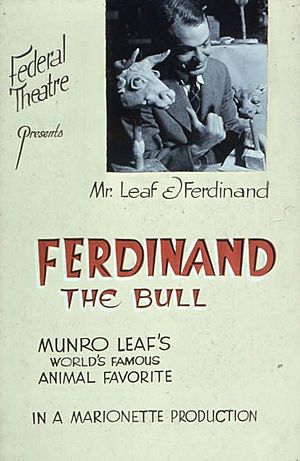Munro Leaf facts for kids
Quick facts for kids
Munro Leaf
|
|
|---|---|
| Born | Wilbur Monroe Leaf December 4, 1905 Hamilton, Maryland |
| Died | December 21, 1976 (aged 71) Garrett Park, Maryland |
Wilbur Monroe Leaf, known as Munro Leaf, was an American author who wrote and drew pictures for children's books. He was born on December 4, 1905, and passed away on December 21, 1976. Over 40 years, he created almost 40 books. He is most famous for his book The Story of Ferdinand (1936). He wrote this classic children's story very quickly, in less than an hour. The book caused some debate around the world.
Contents
Munro Leaf's Early Life
Munro Leaf was born in Hamilton, Maryland. His parents were Charles W. Leaf and Emma India Leaf. He also had an older sister named Elizabeth. By 1910, his family lived in Washington, D.C. His father worked as a machinist there.
Munro Leaf went to the University of Maryland and graduated in 1927. He played lacrosse and was the class treasurer. He then earned a master's degree in English literature from Harvard University in 1931. In 1928, he traveled to Europe for his honeymoon with his wife, Margaret Pope.
Munro Leaf's Career as an Author
Munro Leaf first taught English at Belmont Hill School in 1929. After that, he worked as an editor for a publishing company called Frederick A. Stokes Company. He once said that he realized early on that important truths should be told to young people in ways they could understand.

He wrote The Story of Ferdinand for his friend, the illustrator Robert Lawson. This story is about a gentle bull in Spain. Ferdinand loves to smell flowers more than he likes bullfighting. Some people thought the book was about peace and not fighting. Because of this, the book was banned in Spain. It was even burned in Nazi Germany as propaganda. However, the book was translated into over 60 languages and is still printed today. Walt Disney made a film based on the story, which won an Academy Award in 1938.
Munro Leaf and Robert Lawson worked together again on a book called Wee Gillis. This book is about a boy in Scotland who lives between his father's family in the Highlands and his mother's family in the Lowlands. Wee Gillis was recognized as a Caldecott Honor Book in 1939.
In the 1930s and 1940s, Leaf wrote a regular section for The American Magazine. It was called "Streamlined Samples of the World's Best Stories." In this section, he wrote short, funny summaries of famous books like Ivanhoe and Romeo and Juliet.
The Watchbirds Series
Another well-known creation by Munro Leaf was his Watchbirds cartoon series. These cartoons showed funny comments on how people behave. The series appeared regularly in the Ladies' Home Journal. Later, many of these cartoons were put together into books.
Munro Leaf During World War II
During World War II, Munro Leaf worked for the United States Army. After the war, he offered his skills to the State Department. He wanted to help with international policy. This led to a cartoon book he created. It was published by the Committee for the Marshall Plan. The book was called Who Is the Man Against the Marshall Plan?.
During the war, Leaf also worked with Ted Geisel, who is better known as Dr. Seuss. They created a pamphlet called This Is Ann. It was about a mosquito spreading malaria to soldiers who didn't take safety steps.
After the War
Munro Leaf continued to write many books after his time in World War II. He wrote 25 more books, and two of them were published after he passed away.
Munro Leaf's Personal Life
Munro Leaf died from cancer at the age of 71. He passed away at his home in Garrett Park, Maryland, on December 21, 1976.
His lacrosse stick from the University of Maryland became a special trophy. It is now used for games between Ann Arbor Pioneer and Ann Arbor Skyline high schools. The winning team gets to keep the stick until the next game.
Munro Leaf's Legacy
On April 22, 1995, Munro Leaf was honored. He was added to the University of Maryland Alumni Hall of Fame. Some of his books have been printed again in recent years.
His famous book, The Story of Ferdinand, has also inspired music. The English composer Alan Ridout set the story to music. There is also a French version narrated by Pierre Lebeau. In 1998, the Minnesota Orchestra asked Alice Gomez to write two pieces of music based on The Story of Ferdinand. These pieces, called El Piquete de Abeja and Habanera de Ferdinand, are in a Spanish style.
Selected Works
- Grammar Can Be Fun, 1934.
- The Boy Who Would Not Go to School: Robert Francis Weatherbee, 1935.
- Manners Can Be Fun, 1936.
- The Story of Ferdinand, illustrated by Robert Lawson, 1936.
- Noodle, illustrated by Ludwig Bemelmans, 1937.
- Wee Gillis, illustrated by Robert Lawson, 1938.
- The Watchbirds, 1938.
- Safety Can Be Fun, 1938.
- Fair Play, 1939.
- This Is Ann, She's Dying to Meet You., illustrated by Theodor Seuss Geisel, 1943.
- Health Can be Fun, 1943.
- How to Behave and Why, 1946.
- Arithmetic Can Be Fun, 1949.
- History Can Be Fun, 1950.
- Geography Can Be Fun!, 1951.
- Reading Can Be Fun, 1953.
- Science Can Be Fun, 1958.
- Metric Can Be Fun, 1976.
See also
 In Spanish: Munro Leaf para niños
In Spanish: Munro Leaf para niños

